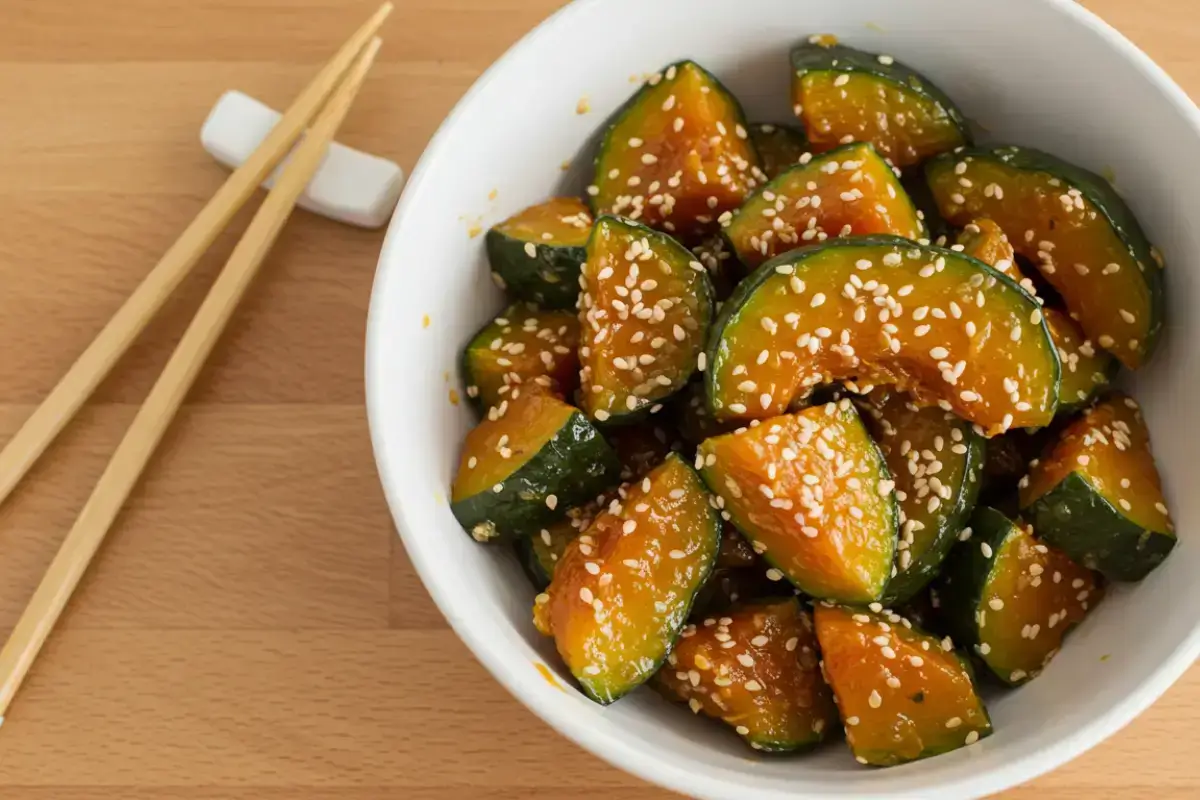Table of Contents
It was a chilly evening, and all I craved was something warm, satisfying, and bursting with flavor. But there was a twist—I wanted it to be completely plant-based, yet full of the rich, savory flavors I loved. That’s when chinese squash recipes kabocha vegan entered the scene, and I was hooked. The perfect balance of sweetness, spice, and heartiness. Curious to know how this vibrant squash can transform your next meal? Keep reading—we’ve got some mouthwatering tips and recipes that will have you rethinking everything you know about vegan cuisine!
Why You’ll Love This Chinese Squash Recipes Kabocha Vegan?
- Packed with nutrition: This dish is a powerhouse of essential vitamins, minerals, and antioxidants, all thanks to the star ingredient—kabocha squash. It’s not only delicious but nourishing too!
- Simple, quick, and uses pantry staples: With just a handful of ingredients you probably already have in your kitchen, this recipe comes together in no time, making it the perfect weeknight meal.
- Perfect for meal prep and customizable for different occasions: Whether you’re prepping for the week or whipping up a special meal, this dish is easy to scale, and you can tweak it to suit your cravings or dietary needs.
- Ideal for vegans and plant-based eaters looking for a flavorful, hearty dish: If you’re craving a satisfying, plant-based dish that doesn’t skimp on flavor, this one’s for you! It’s rich, hearty, and packed with all the goodness you need.
Health Benefits & Nutritional Breakdown
This easy Chinese squash recipe with kabocha vegan ingredients offers a nutritious powerhouse! A single serving is rich in fiber, antioxidants, and vitamins A and C, supporting immune health and eye vision. Kabocha squash is packed with beta-carotene, while garlic and ginger provide anti-inflammatory benefits. The addition of soy sauce adds a savory umami kick, and sesame seeds boost calcium intake. Low in calories, it’s a wholesome dish that keeps you full and nourished without compromising on flavor. Enjoy the health benefits of this vibrant, plant-based dish!
What Ingredients Do You Need for Chinese Squash Recipes Kabocha Vegan?
| Ingredient | Measurement | Description |
|---|---|---|
| Olive Oil | 1 tablespoon | A healthy fat used for sautéing and adding richness to the dish. |
| Kabocha Squash | 1 medium (900g or 2 pounds) | A sweet, tender Japanese pumpkin with a thick skin that softens when cooked. |
| Minced Ginger | 1 tablespoon | A fresh, aromatic root that adds heat and fragrance to the dish. |
| Scallions (green onions) | 2, thinly sliced (white and green parts separated) | Mild onion flavor with a crunchy texture; white part used for sautéing and green part for garnish. |
| Minced Garlic | 2 tablespoons | A fragrant, savory bulb used to enhance the flavor profile of the curry. |
| Water | ¼ cup (60ml) | Used to adjust the consistency of the sauce and help cook the squash. |
| Brown Sugar or Coconut Sugar | ¼ cup (25g) | A natural sweetener that balances the savory and spicy elements of the dish. |
| Low-Sodium Soy Sauce or Tamari | ⅓ cup (80ml) | A salty, umami-rich seasoning; tamari is a gluten-free alternative to soy sauce. |
| Mirin or Rice Wine | ¼ cup (60ml) | A sweet Japanese rice wine that adds depth and a slight sweetness to the dish. |
| Clear Rice Vinegar | 1 tablespoon | A mild, tangy vinegar used to brighten and balance the flavors of the curry. |
| Gochugaru (Korean Red Chili Powder) or Red Chili Flakes | 1 tablespoon | A smoky, spicy powder that provides heat; red chili flakes can be used as an alternative. |
| Toasted Sesame Oil | 1 tablespoon | A fragrant oil made from roasted sesame seeds, adding nutty flavor to the dish. |
| Toasted Sesame Seeds | For garnish | A crunchy, nutty garnish that adds texture and flavor contrast to the curry. |
How to Make Vegan Kabocha Squash Recipes?
Step 1: Preparing the Kabocha Squash
Start by carefully peeling the kabocha squash with a sharp knife or vegetable peeler. Once peeled, cut the squash in half, removing the seeds. Then, chop it into bite-sized chunks, ensuring uniformity for even cooking. For easy Chinese squash recipes kabocha vegan, you can roast the squash at 400°F for about 25-30 minutes, or steam it until tender. Both methods enhance the natural sweetness, making it a perfect base for your flavorful vegan dish.
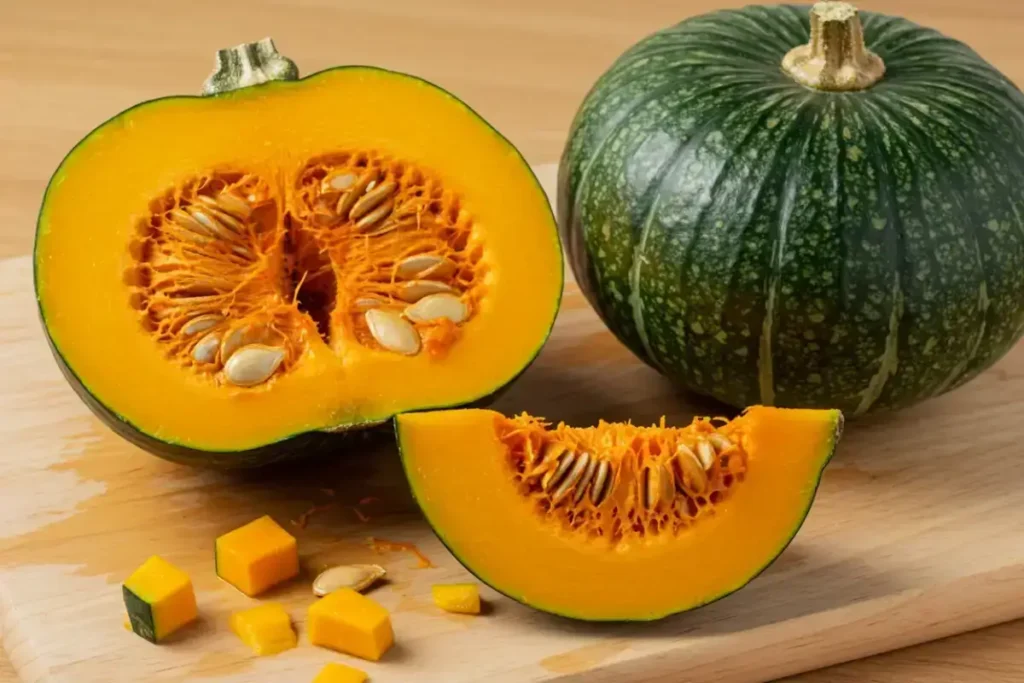
Step 2: Making the Sauce and Stir-Frying Aromatics
For the sauce, blend kabocha squash with a harmonious balance of sweet, salty, and umami flavors. Combine brown sugar or coconut sugar with soy sauce and mirin, creating a rich base. In a hot pan, stir-fry minced garlic, ginger, and scallions until fragrant and golden. This step infuses the dish with aromatic depth. These techniques are key in easy vegan kabocha squash recipes, ensuring the squash soaks up all the delicious flavors.
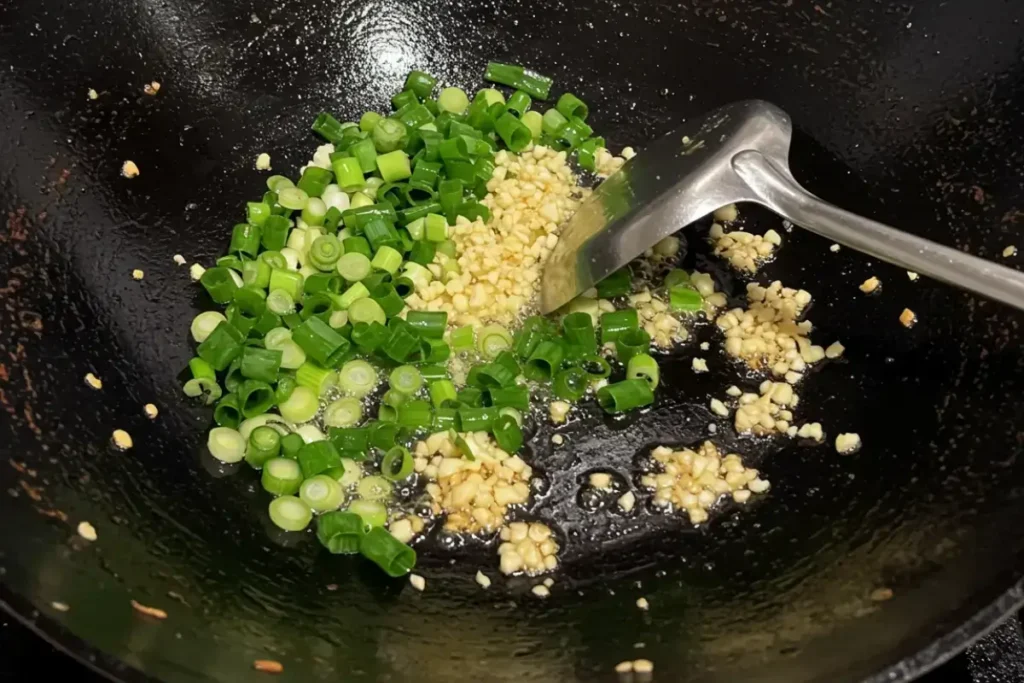
Step 3: Combining the Ingredients
Once the aromatics and sauce are ready, gently add the roasted kabocha squash to the pan, stirring to coat it evenly with the flavorful sauce. Let the mixture simmer over low heat, allowing the squash to absorb the savory, sweet, and umami-rich sauce. Stir occasionally to prevent sticking and ensure the flavors meld beautifully. Continue to cook until the squash is tender, with a glossy finish from the sauce. This step creates a harmonious and satisfying dish.
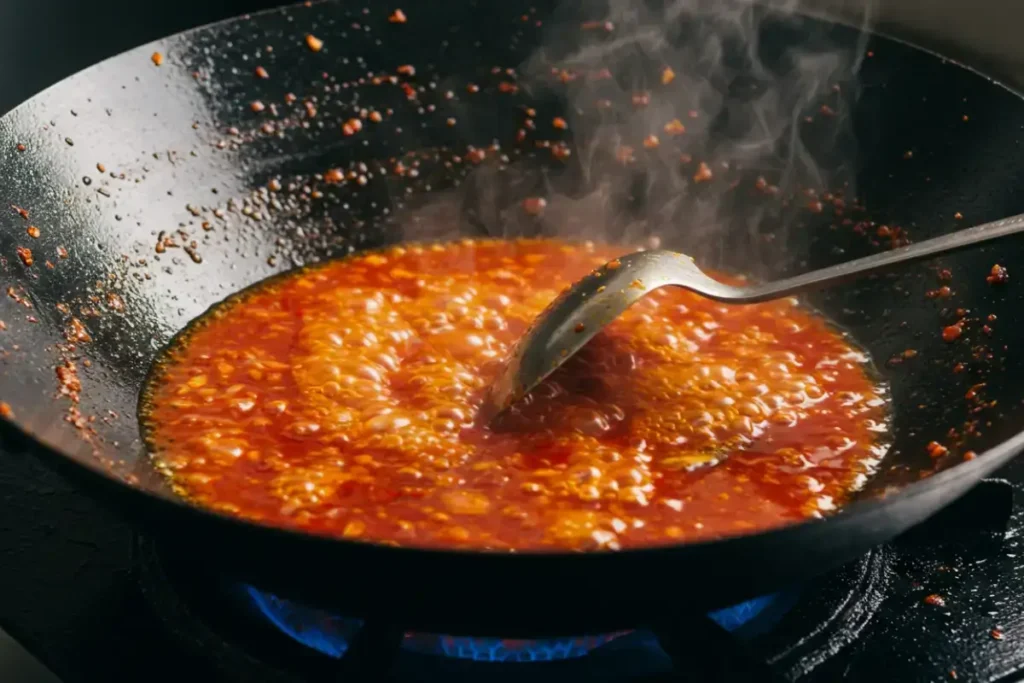
Step 4: Serve the Dish
Transfer the dish to a serving plate, making sure to include any leftover glaze. Drizzle with sesame oil and top with sliced scallion greens and toasted sesame seeds for garnish. Serve right away for the best flavor and presentation.
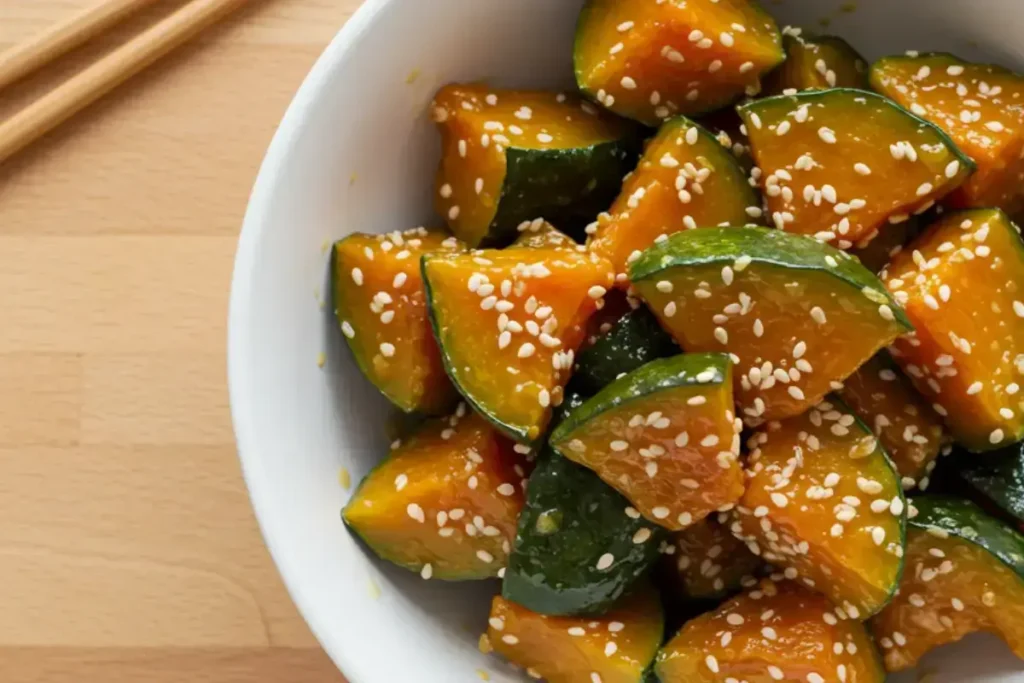
Tips for Success Chinese Squash Recipes Kabocha Vegan:
- Choosing the perfect kabocha squash: When selecting a kabocha squash, choose one that feels heavy for its size and has a firm texture. Look for a deep green rind without soft spots or blemishes, as these can indicate over-ripeness or spoilage. A well-chosen squash ensures a richer, sweeter flavor and a satisfying texture for your dish.
- How to cut and prepare squash safely: Kabocha squash has a tough outer skin, so use a sharp, sturdy knife to slice through it carefully. Cut off both ends, then slice the squash in half to remove the seeds. For easy handling, chop the squash into uniform cubes to ensure even cooking and consistency in texture.
- Adjusting spice levels to taste: Spice tolerance can vary, so feel free to adjust the amount of chili, ginger, or garlic to suit your preferences. Start with a smaller amount and gradually increase to find the perfect balance of heat and flavor that works for you.
- Ensuring the dish is vegan-friendly: Always check your sauces and seasonings to make sure there are no animal-derived ingredients hiding in the mix. Common non-vegan ingredients like fish sauce or honey can sneak into sauces, so choose plant-based alternatives such as tamari or maple syrup to keep your dish fully vegan-friendly.
Serving Suggestions
For an ideal accompaniment to your vegan kabocha squash recipes, try serving this dish with steamed rice or quinoa for a hearty base. Alternatively, stir-fried greens like bok choy or kale will add a fresh, crunchy contrast. If you’re creating a larger, Chinese-inspired meal, this dish pairs beautifully with vegetable dumplings, tofu stir-fry, or a light miso soup. The balance of flavors in this recipe enhances any spread, making it a versatile addition to your plant-based dining experience.
Presentation Tips
Elevate your easy Chinese squash recipes kabocha vegan with a few simple garnishes. Sprinkle toasted sesame seeds over the dish for a delightful crunch, or add fresh cilantro to introduce a burst of color and freshness. A drizzle of chili oil can add a touch of heat and a glossy finish, making the dish look as enticing as it tastes. These finishing touches not only enhance the flavor but also bring an appealing visual contrast to the vibrant squash.
How to Store & Reheat Chinese Squash Recipes Kabocha Vegan
Refrigeration Tips
To preserve the flavor and texture of your vegan kabocha squash recipes leftovers, store them in an airtight container. Allow the dish to cool to room temperature before refrigerating, ensuring it stays fresh longer. Avoid overstacking, as airflow is crucial. Reheat gently to maintain the squash’s tender consistency and the sauce’s vibrant flavors.
Freezing Tips
For meal prep convenience, freeze your kabocha squash recipe in an airtight container or freezer bag, ensuring all air is squeezed out to prevent freezer burn. To reheat, simply thaw overnight in the fridge and warm gently on the stove, preserving flavor and texture.
Mistakes to Avoid When Making Chinese Squash Recipes Kabocha Vegan
- Overcooking: Avoid mushy squash by cooking it just enough to retain its tender yet firm texture. Keep an eye on it while simmering, ensuring it doesn’t turn too soft.
- Using too much oil: While oil adds flavor, excessive amounts can make the dish greasy. Stick to the right balance for a healthier outcome.
- Forgetting flavor balance: Ensure harmony between sweet, salty, and umami flavors. Taste as you go to achieve the perfect mix.
- Skipping garnishes: Garnishes like sesame seeds or fresh herbs elevate the dish, adding texture and a burst of flavor to each bite. Don’t skip this final touch!
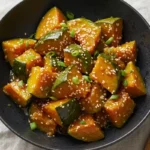
Flavorful & Nutritious Chinese-Inspired Kabocha Squash Recipes (Vegan)
- Total Time: 50 minutes
- Yield: 4 servings 1x
- Diet: Vegan
Description
Discover delicious and easy vegan kabocha squash recipes, perfect for healthy, gluten-free meals. Try our top flavorful dishes today!
Ingredients
- 1 tablespoon olive oil
- 1 medium kabocha squash (900g or 2 pounds)
- 1 tablespoon minced ginger
- 2 scallions (sliced thinly, white and green parts separate)
- 2 tablespoons minced garlic
- ¼ cup (60ml) water
- ¼ cup (25g) brown sugar or coconut sugar
- ⅓ cup (80ml) low-sodium soy sauce or tamari
- ¼ cup mirin or rice wine
- 1 tablespoon clear rice vinegar
- 1 tablespoon gochugaru (Korean red chili powder) or red chili flakes
- 1 tablespoon toasted sesame oil
- Toasted sesame seeds (for garnish)
Instructions
- Prepare the Kabocha Squash
- Peel, halve, deseed, and chop the squash into bite-sized pieces.
- Roast at 400°F for 25-30 minutes or steam until tender.
- Make the Sauce and Stir-Fry Aromatics
- Combine brown sugar, soy sauce, and mirin to create the sauce.
- Stir-fry minced garlic, ginger, and scallions until fragrant.
- Combine Ingredients
- Add roasted squash to the sauce and stir to coat.
- Simmer on low heat until the squash is tender and the sauce is glossy.
- Serve the Dish
- Transfer to plates, drizzle with sesame oil.
- Garnish with sliced scallion greens and toasted sesame seeds.
- Prep Time: 20 minutes
- Cook Time: 30 minutes
- Category: Main Dish
- Method: stovetop
- Cuisine: Asian
Nutrition
- Serving Size: 1 serving
- Calories: 260kcal
- Sugar: 24g
- Sodium: 195mg
- Fat: 9g
- Saturated Fat: 1g
- Unsaturated Fat: 8g
- Trans Fat: 0g
- Carbohydrates: 45g
- Fiber: 5.5g
- Protein: 6g
- Cholesterol: 0mg
Keywords: vegan kabocha squash recipes
FAQs
Can I use a different squash for this recipe?
Yes, you can experiment with other squashes like butternut or acorn in this easy Chinese squash recipe. While the texture may vary slightly, both squashes offer a similar sweetness and hearty texture. Just remember, kabocha vegan dishes thrive on the squash’s rich flavor, so opt for a squash with a dense, creamy flesh.
How do I make this dish spicier or milder?
Yes, you can experiment with other squashes like butternut or acorn in this easy Chinese squash recipe. While the texture may vary slightly, both squashes offer a similar sweetness and hearty texture. Just remember, kabocha vegan dishes thrive on the squash’s rich flavor, so opt for a squash with a dense, creamy flesh.
Do you eat the skin of kabocha squash?
Yes, you can eat the skin of kabocha squash! Its tender, dark green rind becomes soft when cooked, adding extra texture and nutrients to the dish. For a smoother result, feel free to peel it, but don’t discard it if you enjoy a bit of extra bite!
Which is healthier, butternut or kabocha squash?
When comparing butternut and kabocha squash, both offer excellent nutritional benefits, but kabocha squash stands out for its higher content of vitamin A and antioxidants. It’s also lower in sugar and offers more fiber, making it a great choice for those seeking a heartier, nutrient-packed option.
Can you eat kabocha squash seeds?
Yes, kabocha squash seeds are edible and can be a nutritious snack. Simply roast them with a bit of oil and seasoning to enhance their flavor. Packed with protein, healthy fats, and fiber, they’re a great addition to your diet and can be enjoyed as a crunchy topping or stand-alone snack.
What is the easiest way to cut kabocha squash?
The easiest way to cut kabocha squash is by first microwaving it for a few minutes to soften the rind. Then, use a sharp knife to slice off the top and bottom, creating a stable base. Cut the squash in half, scoop out the seeds, and slice it into manageable pieces.
Conclusion
This easy Chinese squash recipe combines simplicity with rich, healthy flavors, making it a perfect addition to your plant-based meals. The kabocha vegan dish is not only nutritious but also versatile, allowing for customization to suit your tastes. Try it today, share your creations with us on our Instagram page, or leave a comment, and explore more vegan Chinese recipes on the blog!

